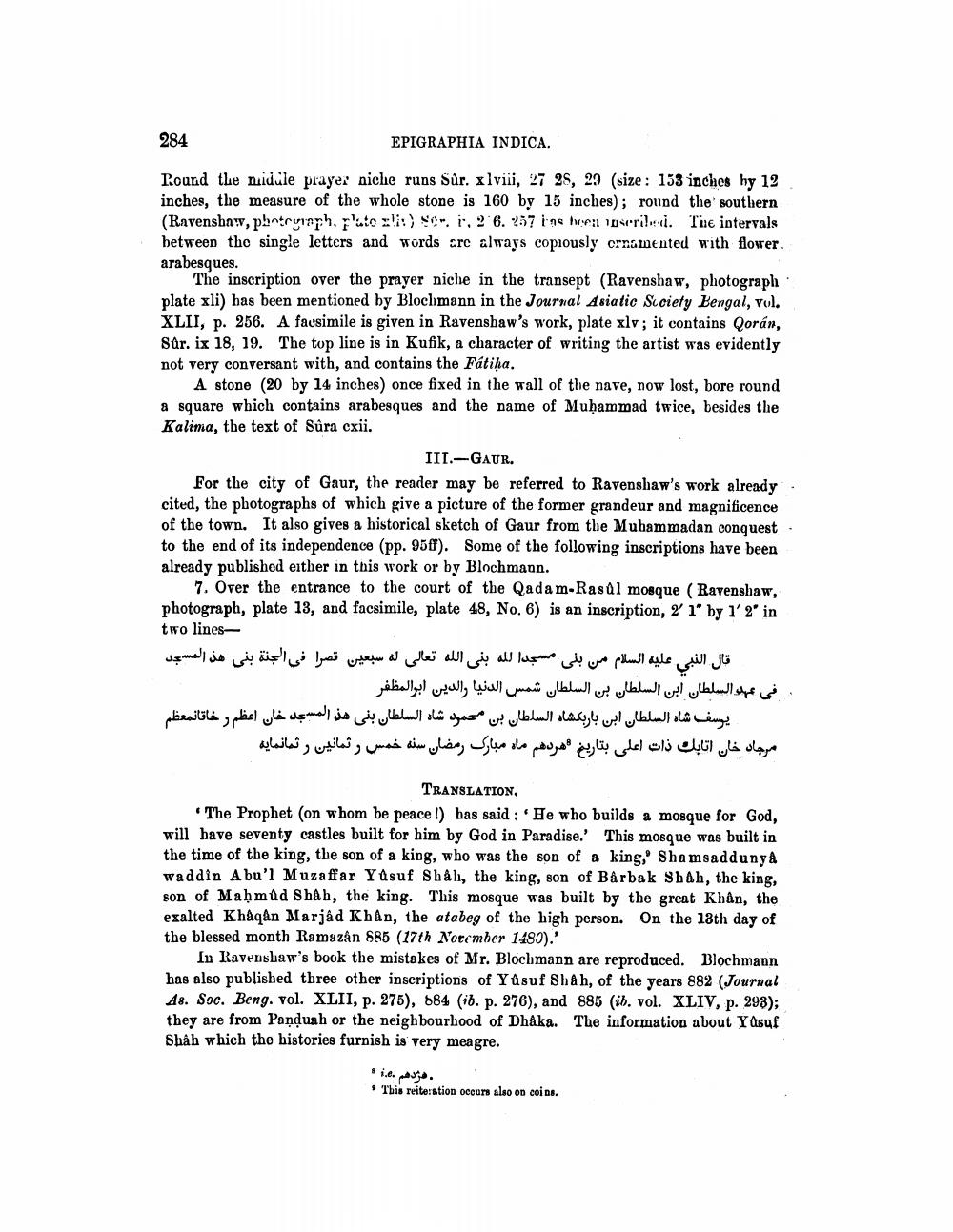________________
284
EPIGRAPHIA INDICA.
Round the muidule prayer niche runs Sûr. xlviii, 27 28, 29 (size: 153 inches hy 12 inches, the measure of the whole stone is 160 by 15 inches); round the southern (Ravenshaw, patryroph, rute !:) Sor. 1, 2 6. 257 instven srili. The intervals between the single letters and words are always copiously crnamented with flower. arabesques.
The inscription over the prayer niche in the transept (Ravenshaw, photograph plate xli) has been mentioned by Bloclimann in the Journal Asiatic Society Bengal, vul. XLII, p. 256. A facsimile is given in Ravenshaw's work, plate xlv; it contains Qorán, Sûr. ix 18, 19. The top line is in Kufik, a character of writing the artist was evidently not very conversant with, and contains the Fátiha.
A stone (20 by 14 inches) once fixed in the wall of the nave, now lost, bore round a square which contains arabesques and the name of Muhammad twice, besides the Kalima, the text of Sûra cxii.
III.-GAUR. For the city of Gaur, the reader may be referred to Ravenshaw's work already. cited, the photographs of which give a picture of the former grandeur and magnificence of the town. It also gives a historical sketch of Gaur from the Muhammadan conquest to the end of its independence (pp. 95ff). Some of the following inscriptions have been already published either in this work or by Blochmaon.
7. Over the entrance to the court of the Qadam-Rasal mosque (Ravenshaw, photograph, plate 13, and facsimile, plate 48, No. 6) is an inscription, ? 1" by 1' 2" in two lines
قال النبي عليه السلام من بنى مسجدا لله بنی الله تعالی له سبعين قصرا في الجنة بني هذ المسجد و في عهد السلطان ابن السلطان بن السلطان شمس الدنيا والدین ابرالمظفر يوسف شاه السلطان ابن باریکشاه السلطان بن محمود شاه السلطان بني هذا المسجد خان اعظم و خاقانمعظم
وثمانين وثمانمایه مرجان خان اتابك ذات اعلى بتاریخ ههردهم ماه مبارک رمضان سنه خمس
TRANSLATION, • The Prophet (on whom be peace !) has said: 'He who builds a mosque for God, will have seventy castles built for him by God in Paradise. This mosque was built in the time of the king, the son of a king, who was the son of a king, Shamsaddunya waddin Abu'l Muzaffar Yusuf Shah, the king, son of Bårbak Sbah, the king, son of Mahmud Shah, the king. This mosque was built by the great Khân, the exalted Khaqan Marjad Khan, the atabeg of the high person. On the 13th day of the blessed month Ramazan 885 (17th Notember 1489).'
In Ravenshaw's book the mistakes of Mr. Blochmann are reproduced. Blochmann has also published three other inscriptions of Yusuf Shah, of the years 882 (Journal As. Soc. Beng. vol. XLII, p. 275), 884 (ib. p. 276), and 885 (ib. vol. XLIV, p. 293); they are from Panduah or the neighbourhood of Dhaka. The information about Yusuf Shah which the histories furnish is very mea gre.
* i.e. . • This reiteration occurs also on coins.




